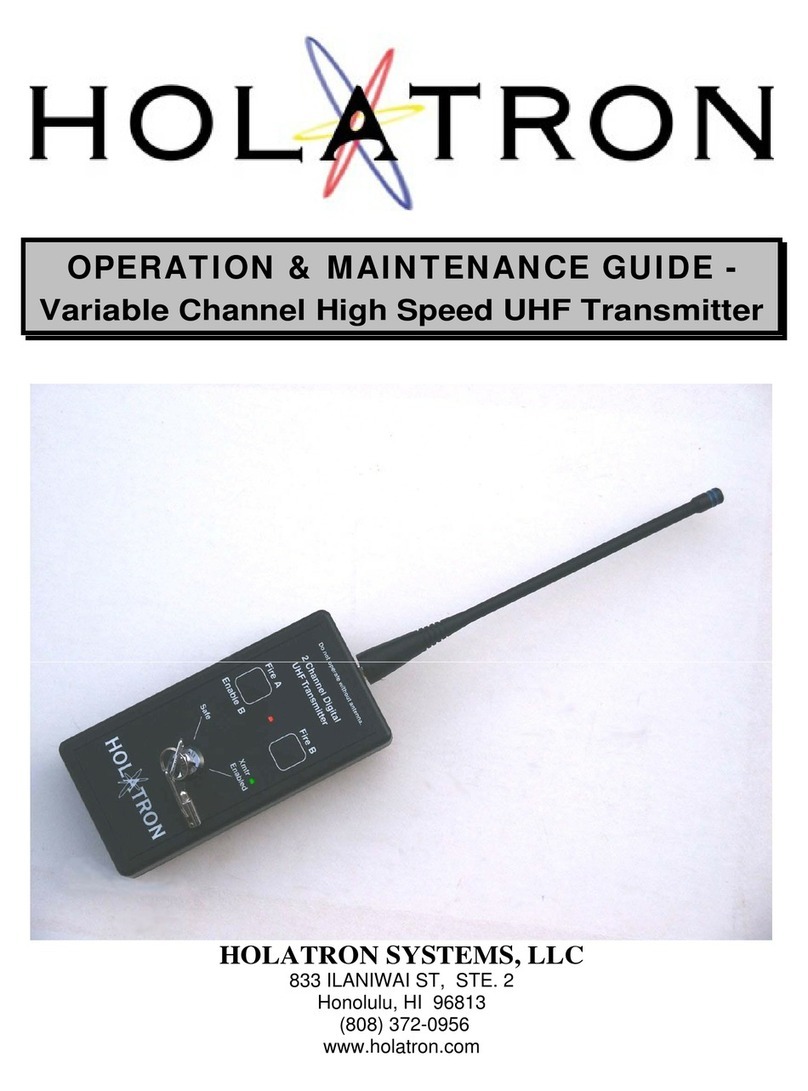2
of 1
4
WARNING
Holatron Systems specializes in the design and manufacture o
f standard and custom electronic
control systems where reliability and error free data communication are critical. The transmitter
described in this manual is part of a system intended to remotely actuate pyrotechnic or other
hazardous devices, and the com
ponents of this system have been carefully designed to
minimize the possibility of accidental actuation of such devices. Holatron’s design goal is to
ensure that data communication errors due to radio interference or to insufficient signal strength
due to
low battery, exceeding specified range, or conductive objects in the signal path will result
in failure of intentional actuation rather than unintended actuation. Techniques used to achieve
this design goal are described in section 1.
9
. Though the probabil
ity of unintended actuation is
extremely small, it cannot be guaranteed to be zero. Therefore,
it is important that the user
not enable the receiver until all persons who might be harmed by accidental actuation
are in a safe area
.
As a condition of purcha
se, the user must acknowledge awareness and agreement that
utilization of this product and participation in activities utilizing fireworks, rockets, and explosives
is an ultra
-
hazardous activity carrying implied and explicit risks of injuries and damages t
o the
user and to other participants. The user assumes the risk connected with the utilization of this
product and all risks of participation in the activities for which this product is sold. User
acknowledges that he/she/it has the necessary and required
skill, expertise, training and
licensing, as may be applicable or necessary by custom, usage, trade or law, to engage and
participate in the ultra
-
hazardous activities connected with the use, purchase, transportation, or
employment of the products sold un
der this agreement. User acknowledges that Holatron
Systems, LLC, has not and will not conduct any investigation into the skill, expertise, training
and licensing, as may be applicable or necessary by custom, usage, trade or law, of the user or
of user’s a
gents, employees and assigns, to engage and participate in the ultra
-
hazardous
activities connected with the use, purchase, transportation, or employment of this product. User
specifically agrees that Holatron Systems, LLC, its officers, employees, and age
nts shall not be
liable for any claim, demand, cause of action of any kind whatsoever for, or on account of death,
personal injury, property damage or loss of any kind resulting from or related to user’s or user’s
employees’, agents’ or assigns’ use of thi
s product, and user agrees to indemnify, defend in any
action at law, and hold harmless Holatron Systems, LLC, from same, whether brought by the
user, user’s agent, or assigns, or any third party.
Usage of this transmitter is authorized under FCC Rules an
d Regulations as listed in CFR
47
Ch.1 (10
-1-
96 Edition), p
art 15, subpart C, sections 15.209 and 15.231. This equipment has
been tested and assigned
FCC ID number: OI4RFLS1XT.
Any changes or modifications to the hardware not expressly approved by
the party
responsible for compliance could void the user’s authority to operate the equipment.




























